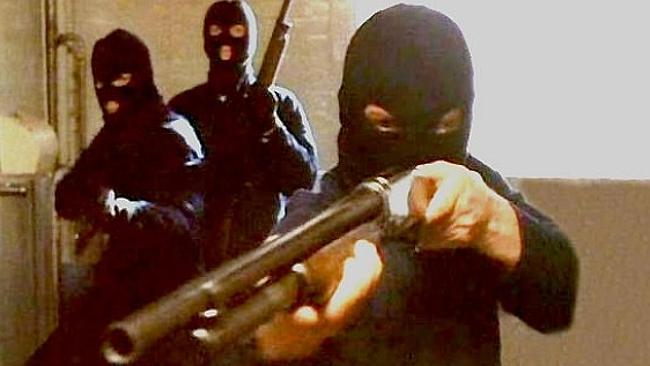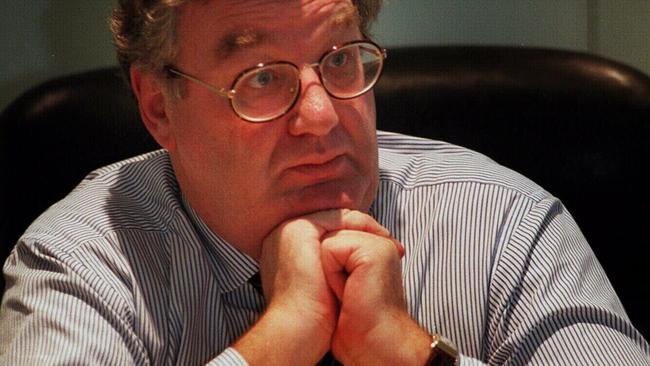Defence barrister Philip Dunn on Australia’s most notorious robbery
IT WAS a crime of greed, maybe even one of revenge, but it was pulled off so meticulously that nobody was ever convicted.

IT WAS a crime of greed, maybe even one of revenge.
But it was one that was planned for months and pulled off so meticulously, nobody was ever convicted.
The Great Bookie Robbery is one of Australia’s most notorious crimes, where six bandits filled totes with millions of dollars in just minutes. It was even the basis for a 1986 television miniseries.
Still nobody knows what happened. The money was never found and the thieves either disappeared or were killed.
The closest this crime got to being solved was the arrest of bandit Norman Lee, the only gang member to face court over the robbery — but he was acquitted.
It’s been 40 years since the brazen crime and Lee’s solicitor at the time, defence barrister Philip Dunn, QC, reveals what he knows, what questions still remain and his sneaking regard for their bold heist.
THE CRIME
It was autumn in Melbourne, April 1976. The city was no doubt windy and cold with amber leaves cluttering the gutters.
Six men gathered a couple of weeks before Easter and plotted to steal from bookies who were sorting money to give to punters.
“The men who executed it were not only experts in their particular trades, but brave and bold in what they did,” Mr Dunn said.
It was in the days when bookmakers did all their business in cash at the Victoria Club on Queen Street. Bookies would secure their money on the third floor of the Victoria Club before it was picked up by the National Bank. It was a prime opportunity to steal.
In the weeks prior to the robbery, one of the bandits bypassed the club’s security system and removed a number of bolts from the fire escape access door.
He cut them in half and lightly glued them back together, so the bandits could just push the door to gain entry to the building later on.
Six weeks prior to the robbery, they tampered with the elevators so they would continuously jam and get stuck between floors.
Nobody would be able to go up or down the lift while these men committed their third-floor robbery.
It was April 21, the day they finally pulled off the heist.
They hid while waiting for the Armaguard truck to deliver the cash to the building.
“The truck actually got a flat tyre on the way and they were 15 minutes late,” Mr Dunn said. “The bandits were actually very bold and brave because they were waiting, ready to go, and the truck didn’t come.”
Once the money was delivered, the bandits stormed the building. They were masked and some were armed with M60 machineguns.

“They made a lot of noise and made people lie on the floor, there were more than 100 people in the building when they raided it,” Mr Dunn said.
“There was little conversation but there was one thing said that gave people a clue about who they were.”
Among the hostages was prize fighter Ambrose Palmer and while the bandits were yelling at everybody to get down, one turned to Palmer and said “that means you Ambrose”.
“That meant the bandit was either from Melbourne or he was a person who went to the fights,” Mr Dunn said.
In less than 10 minutes they had escaped with millions of dollars.
The exact amount stolen was never known, but it has been said it could have been as much as $15 million.
Lee was the only person arrested after he used new bank notes that had only been delivered to the bookie club.
In the end, however, there wasn’t enough evidence and police could not prove a link between the robbery and the fact Lee was in possession of the notes.
“It didn’t mean he did it, it just meant he had the money,” Mr Dunn said. “He was pretty bold, when police went to the dim sim factory where he worked they wanted to look at the safe but he refused.
“The police got a safe cracker and cut it open and when they opened it nothing was inside. He was just one of those blokes who didn’t want to help.”

THE RUMOURS
Nobody quite knows how the gang, Raymond “Chuck” Bennett, Norman Lee, Ian Carroll, Laurence Prendergast and Brian and Leslie Kane, smuggled the money out of the Victoria Club.
Mr Dunn said he heard two stories about what happened to the millions.
“One is that money was removed in a laundry van,” he said. “The other, I heard they actually rented another office in the building and moved the money upstairs and left it there for several weeks, but who knows? They were smart guys.”
Despite defending Lee during his court case, Mr Dunn said he was airtight about what happened.
“Norman Lee wouldn’t have told a priest in confession what happened,” he said. “That’s how it was in those days.”
Lee’s parents made dim sims and spring rolls and there was a rumour among those in the underworld that several people who went missing, were put through Lee’s dim sim machine and later eaten by those who attended the footy.
“That’s part of the rumour mill in Melbourne’s underworld,” Mr Dunn said.
Over the years there have also been many rumours about what the gang did with the money they stole.
“Some said a couple of bandits went to Manila and opened up some bars there,” he said. “Others believed some of the money was wisely invested.”

WHERE ARE THEY NOW?
Lee was shot dead in another brazen robbery at Tullamarine airport in Melbourne in 1992.
He was trying to intercept millions of dollars being transported. He was killed by police during a shootout.
Leslie was allegedly killed in 1978 by Bennett, the mastermind behind the Great Bookie Robbery. Bennett was accused, but later acquitted.
Bennett was then believed to have been shot by Leslie’s brother Brian — the other Kane bandit involved in the bookie robbery — in 1979 outside a Melbourne courthouse.
Brian was shot by two masked men while at his local drinking spot, the Quarry Hotel, in 1982. Carroll was also shot dead in 1983.
Nobody knows what happened to Prendergast, he went missing in 1985 and has never been found.
“He could be an old man now sitting in front of a radiator in winter having chicken soup,” Mr Dunn said. “There are few people who can reminisce about the good old days.”


‘THEY PLANNED IT LIKE A HEIST MOVIE’
“Those were the days when crime was crime,” Mr Dunn said. “They were bandits and not drug addicts.”
As an older criminal barrister, Mr Dunn said he looked at those days and in a funny way, had a sneaking regard for those old-fashioned villains who didn’t just rely on drugs or guns.
“They plotted and planned their activity like a heist movie.”
Being one of the most notorious crimes in Australia’s history, Mr Dunn said nobody had come close to pulling off something of the same scale. But he said it was a lot harder to catch crims back then.
“In those days the underworld had a code of silence,” he said. “These days, drug addicts will snitch on one another as soon as a policeman says boo.
“Law enforcement also uses a variety of modern technology now to track people’s movements and find out what they are doing. That was never possible 40 years ago.”
Despite being Lee’s solicitor, Mr Dunn said he doesn’t really remember him as a person.
“I remember him as an old-fashioned crim who wouldn’t betray anybody and wouldn’t say much of anything to anybody and lived in code of the underworld as it then was,” he said.




